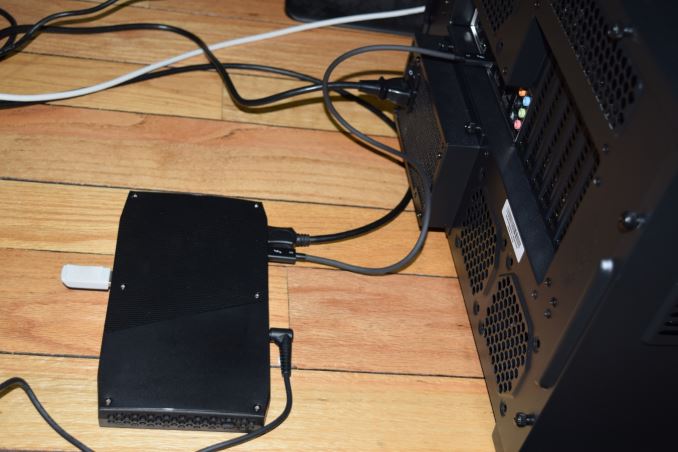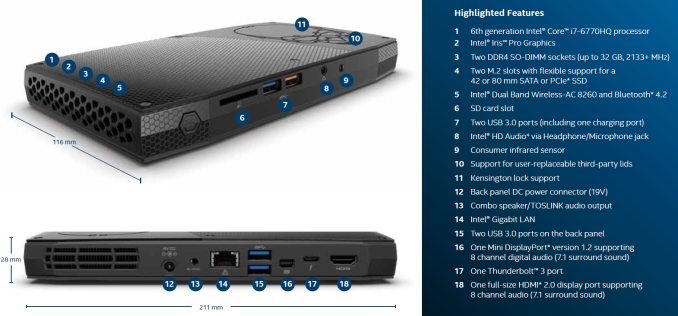The Intel Skull Canyon NUC6i7KYK mini-PC Review
by Ganesh T S on May 23, 2016 8:00 AM ESTMiscellaneous Aspects and Concluding Remarks
One of the more impressive aspects of the Skull Canyon NUC6i7KYK is the reappearance of Thunderbolt in a mini-PC. We have already covered Thunderbolt 3 in good detail. From the perspective of a Skull Canyon evaluation, the Thunderbolt 3 port does deserve a bit of attention. It must be noted that this USB Type-C port can also act as a USB 3.1 Gen 2 host port. Our evaluation of this feature is in two parts - we first hooked up a SanDisk Extreme 900 1.92TB USB 3.1 Gen 2 SSD and ran a quick speed test. We were able to see results similar to our review numbers, indicating that the USB 3.1 Gen 2 mode was indeed active. For the Thunderbolt part, we decided to check out Thunderbolt networking with our direct-attached storage testbed.
A Thunderbolt cable between two PCs is enough to create a Thunderbolt network
Connecting the Thunderbolt ports on the two machines and allowing the PCs to talk to each other automatically creates a 10Gbps network adapter. For a setup with just two machines, it is enough to just set static IPs on the interfaces of both machines in the same subnet, and setting the network location to private so that the machines can talk to each other. We configured a RAM drive on the testbed and mapped it as a network drive on the NUC6i7KYK, Running CrystalDiskMark on the mapped drive showed read speeds of 700 MBps and write speeds of 620 MBps, indicative of a 10Gbps link. The gallery below presents some screenshots of the benchmarks as well as the Thunderbolt networking setup steps.
Moving on to the business end of the review, let us get the complaints out of the way - While the size and form-factor of Skull Canyon are impressive, the acoustic profile is not that great. We would gladly trade a modest increase in the footprint of the system for lower fan noise. That said, the fan noise is in no way comparable to the BRIX Gaming lineup. It is just that it is not as silent as the traditional NUCs.
On the board layout front, we are unable to fathom why the CPU's PCIe lanes are not used at all. It would have been great to have a dual-port Alpine Ridge controller hang directly off the CPU's PCIe lanes. Finally, the ports on the chassis could have done with better spread. The two pairs of USB ports are such that one occupied port ends up making it difficult to utilize the other one in the pair. A port on one of the sides, or, on the lid (without relying on third-party designs), would be very welcome.
But with the above caveats in mind, Skull Canyon is definitely a great product. Simply put, it packs the most punch among systems with similar footprints. It is excellent for casual gamers, but, unfortunately, stops short of being a replacement for systems like the Zotac ZBOX MAGNUS EN970 or the ASRock VisionX 471D - two small form-factor PCs that integrate discrete GPUs at the cost of a larger footprint compared to Skull Canyon. The Thunderbolt 3 port, with an external GPU dock, can somewhat make up for the lack of a discrete GPU for gamers. However, the cost factor becomes a major issue. The 4C/8T configuration of the Core i7-6770HQ is also attractive to consumers looking for a small form-factor system with a powerful CPU, but, they must remember that some price premium is being paid for the Iris Pro graphics.
I am actually looking forward to what vendors like Zotac and ASRock can do with a similar design. If they could take a Skylake-H processor without Iris Pro (say, Core i7-6820HQ), and use the PCIe lanes off the CPU to hook up a mobile discrete GPU, it could deliver the best of both worlds - all the 45W TDP of the CPU can be used to provide raw processing power for CPU-intensive workloads, while a dGPU can handle graphics duties with a separate power budget.
To summarize, Intel has indeed managed to change the game with the NUC6i7KYK. A look at the increase in the gaming capabilities over the previous generation 'gaming' NUCs make the Skull Canyon updates to appear evolutionary in nature. However, the overall platform capabilities (including a much more powerful -H series CPU instead of a -U series CPU, as well as the integration of Thunderbolt 3 and dual M.2 PCIe 3.0 x4 SSD slots) are enough to justify the price premium ($650 for the barebones configuration).


















133 Comments
View All Comments
ragenalien - Monday, May 23, 2016 - link
Could we get a comparison between this and the iris pro 6200? Seems like there isn't much difference performance wise, but there should be.defaultluser - Monday, May 23, 2016 - link
Skylake gets much better GPU performance/watt than Broadwell did, as evidenced by the NUC with 48 EU 64MB eDRAM being fed by just 23w continuous. That's a huge improvement form the 45w this beast used to take!I think the only surprise for me was just 40% performance improvement over the 4770r. I always assumed the 4770r was bandwidth-limited, but I guess the eDRAM cache was enough to keep things fed.
But yeah, pointless product continues to be pointless. Intel charges a premium for these things because they take up more die space and require dedicated eDRAM cache to feed them...just like discrete GPUs take up more die space, and require dedicated DRAM to feed them. Where is the efficiency gain in this crap?
defaultluser - Monday, May 23, 2016 - link
Oh, I just noticed the review uses 2133 DDR4, which would account for the 40% performance increase we saw. I thought for sure a "premium gaming" platform like this would ship with z170, so I didn't give the test setup a second glance.I guess Intel cheaping-out with H170 has forever doomed this machine to mediocrity. Too bad, dropping ten bucks more on the Z170 would have allowed some much more interesting memory configurations. With DDR4 2133 we're probably castrating performance.
tipoo - Monday, May 23, 2016 - link
"Our only concern is that the cooling solution keeps the temperature of the cores too close to the junction temperature during periods of heavy CPU load."My rMBP 15", Iris Pro only model, routinely hovers at the tJunction max at load. Is this a real concern? Or is it designed to do this?
BrokenCrayons - Monday, May 23, 2016 - link
There's probably a little wiggle room built into the processor's design by its engineers, but according to Intel's site here: http://www.intel.com/content/www/us/en/support/pro..."Tjunction Max is the maximum temperature the cores can reach before thermal throttling is activated. Thermal throttling happens when the processor exceeds the maximum temperature. The processor shuts itself off in order to prevent permanent damage. Tjunction Max (Tj Max) is also referred to as TCC Activation Temperature in certain processor datasheets."
Basically, reaching the Tjunction means the CPU is close to shutting itself off to prevent damage. That might mean there are longevity implications related to brushing up against that upper ceiling on a regular basis, but I haven't seen any statistical data regarding a meaningful sample of processors put under such conditions failing more often during their few years of useful life due to CPUs going bad just because the OEM decided to implement a cooling solution that allows the processor to wander up to the Tjunction temp when it's working hard.
I think a bigger concern might be looking into whether or not the rMPB in general will approach Tjunction under load or if that's abnormal. Abnormalities might point to some sort of problem with your specific laptop. I don't know what's status quo for your hardware so its hard to say if that's something you should worry about.
tipoo - Monday, May 23, 2016 - link
Yeah, that's something I looked into, Anandtechs own retina macbook pro 15" review only pegged them at going up to 76 ish celsius if memory serves, but that was the older dGPU model with the 650M. From the threads I'm seeing, the Iris Pro model does regularly hover at 99-101C, I'm guessing since the GPU grunt is right beside the CPU on a single die so heat isn't spread wider like the dedicated GPU model.I don't see any reports of this model failing though, so I'd hope they tested extensively at 100 degrees and found it was fine, and so allowed the processor to keep its boost long enough to get there.
I do wish they could have just added another few mm so that the cooling was better and the CPU and GPU could stay at boost longer, and with that room they could have added some mm to the keyboard too (which I consider the absolute minimum in key travel now).
tipoo - Monday, May 23, 2016 - link
Plus they also only tested Half Life 2, which probably allowed the CPU and GPU not to be at max all the time as it's so old.8steve8 - Monday, May 23, 2016 - link
give us a 65W CPU with iris pro , add a couple inches in height... and use the stock retail CPU cooler. Add USB-c in the front. Use USB power delivery usb-c for power.Done, the perfect little pc.
TheinsanegamerN - Monday, May 23, 2016 - link
Except the niche NUCs fill dont want a NUC the size of a MINI-ITX case. Not to mention intels stock cooler is not the quietest nor the best cooler in existence.8steve8 - Monday, May 23, 2016 - link
well a couple inches of height would not put it near the average mini-itx case size.It's impressive that these NUCs are small, but they goes a bit extreme when they use laptop chips and cooler designs meant for laptops. We can get a very small desktop without sacrificing CPU performance and acoustics/thermals.
Use 65W+ chips w/iris pro, full size intel retail heatsink, usb-c power delivery... no wasted space with expansion slots. 1 m.2 should be the only internal slot.